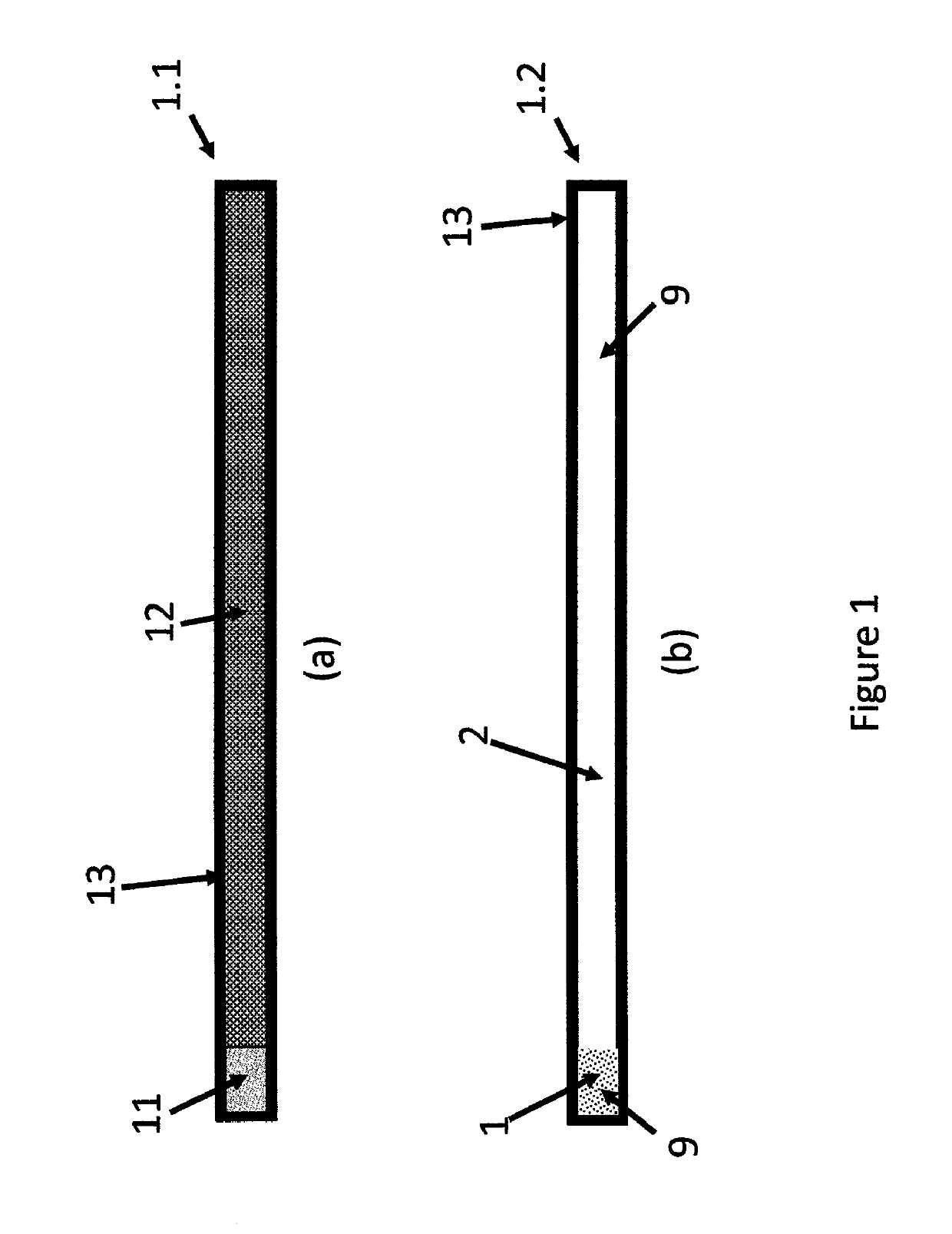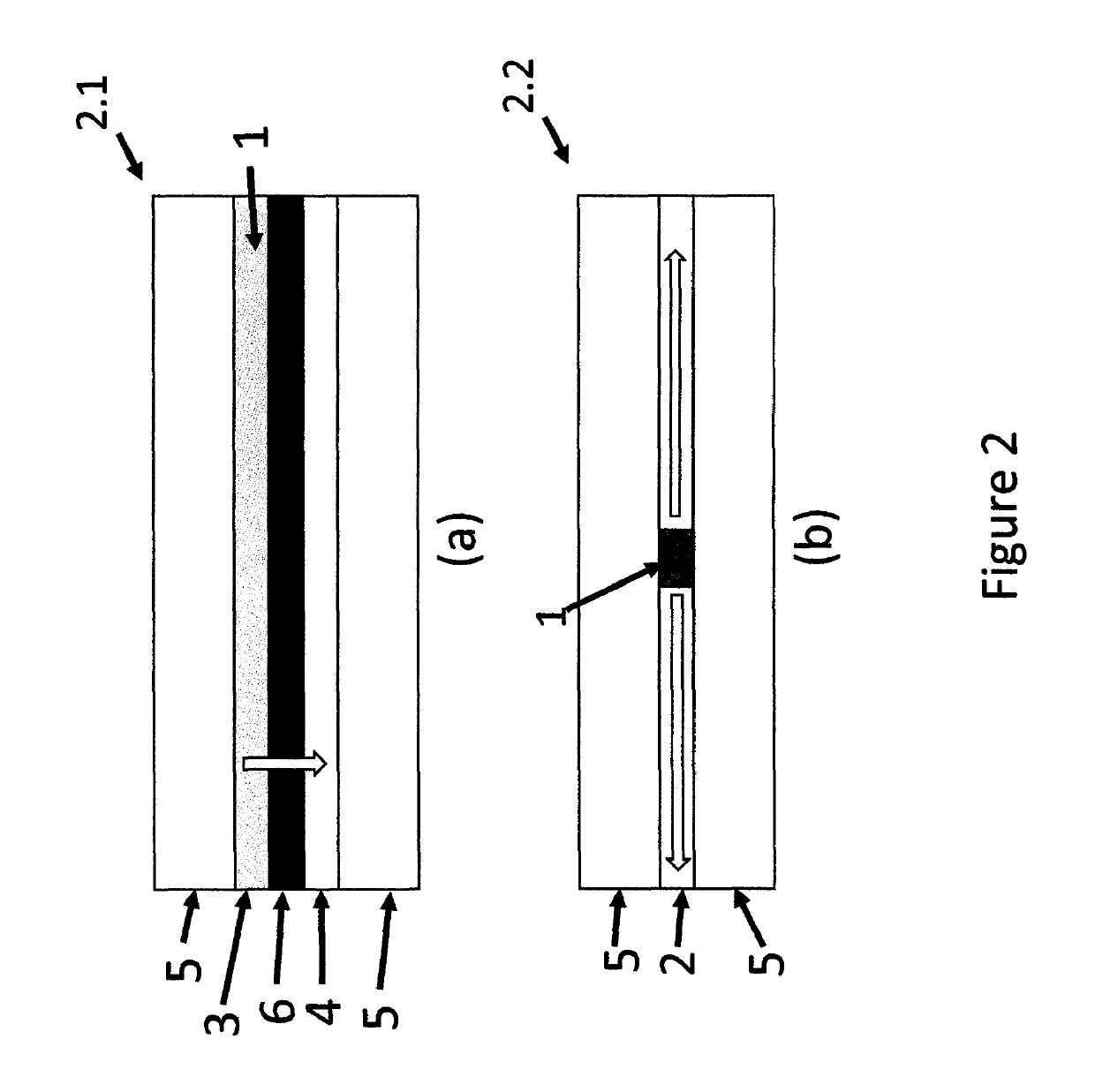Indicating devices based on lateral diffusion of a mobile phase through a non-porous stationary phase
a technology of mobile phase and indicating device, which is applied in the direction of instruments, horology, analysis using chemical indicators, etc., can solve the problems of failure in practice, devices that have not been completely satisfactory, and microwave ovens that do not heat food uniformly, etc., to increase the rate of diffusion of mp, increase the effect of diffusion ra
- Summary
- Abstract
- Description
- Claims
- Application Information
AI Technical Summary
Benefits of technology
Problems solved by technology
Method used
Image
Examples
example 1
nd Comparison Experiments of Known Art and Current Invention with a Fluid MP and a Solid MP
[0400]In order to obtain a solid MP on SP, 0.1 g of methyl yellow was dissolved in 0.25 g of THF, a volatile solvent. In order to get liquid or semi-solid MP, 0.1 g of methyl yellow was dissolved in 0.25 g of benzyl ether, a non-volatile solvent. A drop each of these two solutions was placed on three SP (i) cellulose / copying paper as a porous SP, (ii) a polyester film coated 50 microns of S85 PSA without any accelerator and (iii) a polyester film coated with 50 microns of S85 PSA containing 50% bis(2-ethylhexyl sebacate) as shown in FIGS. 13(a1), 13(a2) and 13(a3). S85 is a pressure sensitive solvent based acrylic adhesive supplied by Avery Dennison, Painesville, Ohio. THF being highly volatile solvent (boiling point 66° C.), it evaporated within minutes at room temperature and spots of dry powder of the dye ware obtained. The spots of benzyl ether remained wet as it is a high boiling (boiling...
example 2
a SP
[0410]A large number of dyes were dissolved in proper solvents and spotted on 50 micron thick layer of S85 on 40 micron polyester film, let the solvents evaporate, laminated with another 40 micron polyester film and stored in an over at about 80° C. Colored spots of many dyes grew at different speeds depending upon the nature of the dyes. Ionic dyes either did not grow or grew very slowly. The spots of dyes with lower molecular weight, such as methyl yellow usually grew rapidly. Dyes with moderate molecular weight, such as Sudan II grew slowly while dyes with very high molecular weight grew very slowly or did not grow.
[0411]In order to study effect of time on migration of the boundary, 0.1 g methyl yellow was dissolved in 0.25 g of THF. Drops of the solution were placed on a 40 micron polyester film coated with 50 micron thick layer of S85. THF evaporated within minutes at room temperature and spots of dry powder of the dye ware obtained. The coating was laminated with a clear p...
example 3
Adhesive as a SP
[0412]We discovered that it is not necessary to have a PSA as SP for the devices of this invention. A number of hot melt, non-tacky polyurethane and acrylic hot melt adhesives coated on polyester films were obtained from different distributors and manufacturers. Dry spots of methyl yellow and Sudan II in THF were prepared on the hot melt adhesive and laminated either with a clear polyester film or with the same hot melt adhesive film using a heat laminator between 110° C. and 150° C. depending upon the nature of the hot melt adhesive. The samples were annealed at different temperatures. FIG. 14(b) shows different stages of growth of the Sudan II on a 25 micron thick layer of an acrylic hot melt adhesive (a polyester film coated with an acrylic hot melt adhesive supplied by Transilwrap, Bethlehem, Pa.) with time at 60° C. When the SP is an acrylic hot melt adhesive the growth of the spot was lower than that of PSA.
[0413]In another experiment, a 25 micron polyethylene ...
PUM
| Property | Measurement | Unit |
|---|---|---|
| temperature | aaaaa | aaaaa |
| pore size | aaaaa | aaaaa |
| activation energy | aaaaa | aaaaa |
Abstract
Description
Claims
Application Information
 Login to View More
Login to View More - R&D
- Intellectual Property
- Life Sciences
- Materials
- Tech Scout
- Unparalleled Data Quality
- Higher Quality Content
- 60% Fewer Hallucinations
Browse by: Latest US Patents, China's latest patents, Technical Efficacy Thesaurus, Application Domain, Technology Topic, Popular Technical Reports.
© 2025 PatSnap. All rights reserved.Legal|Privacy policy|Modern Slavery Act Transparency Statement|Sitemap|About US| Contact US: help@patsnap.com



